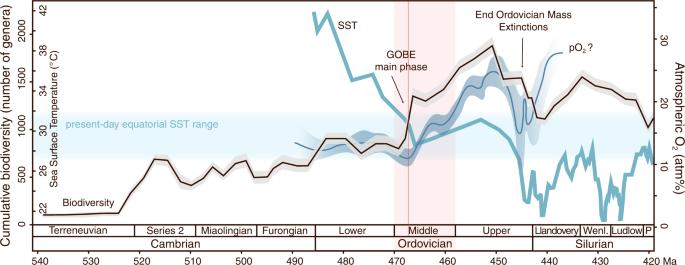奥陶纪生物多样性大事件主要阶段的稳定海洋氧化还原作用
IF 8.1
1区 地球科学
Q1 ENVIRONMENTAL SCIENCES
引用次数: 3
摘要
奥陶纪生物大分化事件(GOBE)代表了有记录以来海洋生物多样性的最大增长。究竟是什么原因导致了这一转变,人们对此争论不休。一种假说认为,大气氧含量的上升推动了生物多样性的增加,其前提是动物的新陈代谢需要氧气。在这里,我们展示了来自中奥陶纪海洋碳酸盐岩演替的铀同位素数据,这些数据表明,在全球海洋氧化还原稳定的情况下,生物种类的丰富度出现了最急剧的上升。海洋氧合作用出现较晚,不可能推动生物多样化。在生物多样性最大增长时期(大平洋-达里维利洋早期),稳定的海洋缺氧区占主导地位,此时演化类属的预期寿命大大延长。随后,海洋氧化还原条件不稳定,海洋碳循环紊乱,相对多样化率下降。因此,我们认为海洋氧化还原稳定是促进建立更具弹性的生态系统的一个因素,从而使海洋动物生命得以辐射。根据对瑞典南部海洋碳酸盐的铀同位素分析,奥陶纪生物多样化大事件之前的时期以稳定的海洋缺氧区为特征,之后大气中的氧气才大幅增加本文章由计算机程序翻译,如有差异,请以英文原文为准。

Stable ocean redox during the main phase of the Great Ordovician Biodiversification Event
The Great Ordovician Biodiversification Event (GOBE) represents the greatest increase in marine animal biodiversity ever recorded. What caused this transformation is heavily debated. One hypothesis states that rising atmospheric oxygen levels drove the biodiversification based on the premise that animals require oxygen for their metabolism. Here, we present uranium isotope data from a Middle Ordovician marine carbonate succession that shows the steepest rise in generic richness occurred with global marine redox stability. Ocean oxygenation ensued later and could not have driven the biodiversification. Stable marine anoxic zones prevailed during the maximum increase in biodiversity (Dapingian–early Darriwilian) when the life expectancy of evolving genera greatly increased. Subsequently, unstable ocean redox conditions occurred together with a marine carbon cycle disturbance and a decrease in relative diversification rates. Therefore, we propose that oceanic redox stability was a factor in facilitating the establishment of more resilient ecosystems allowing marine animal life to radiate. The period leading up to the Great Ordovician Biodiversification Event was characterised by stable marine anoxic zones with a substantial increase in atmospheric oxygen occurring only after this, according to uranium isotope analyses of marine carbonates from southern Sweden
求助全文
通过发布文献求助,成功后即可免费获取论文全文。
去求助
来源期刊

Communications Earth & Environment
Earth and Planetary Sciences-General Earth and Planetary Sciences
CiteScore
8.60
自引率
2.50%
发文量
269
审稿时长
26 weeks
期刊介绍:
Communications Earth & Environment is an open access journal from Nature Portfolio publishing high-quality research, reviews and commentary in all areas of the Earth, environmental and planetary sciences. Research papers published by the journal represent significant advances that bring new insight to a specialized area in Earth science, planetary science or environmental science.
Communications Earth & Environment has a 2-year impact factor of 7.9 (2022 Journal Citation Reports®). Articles published in the journal in 2022 were downloaded 1,412,858 times. Median time from submission to the first editorial decision is 8 days.
 求助内容:
求助内容: 应助结果提醒方式:
应助结果提醒方式:


